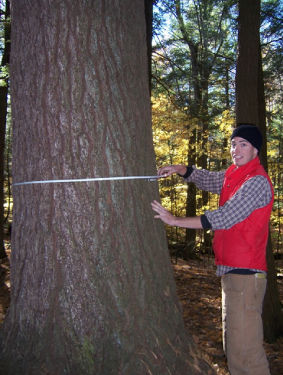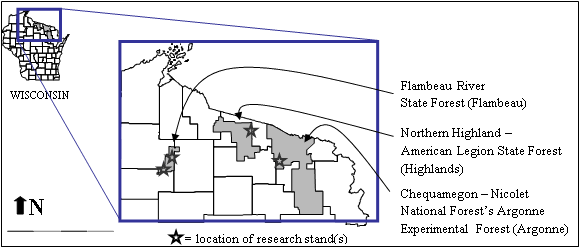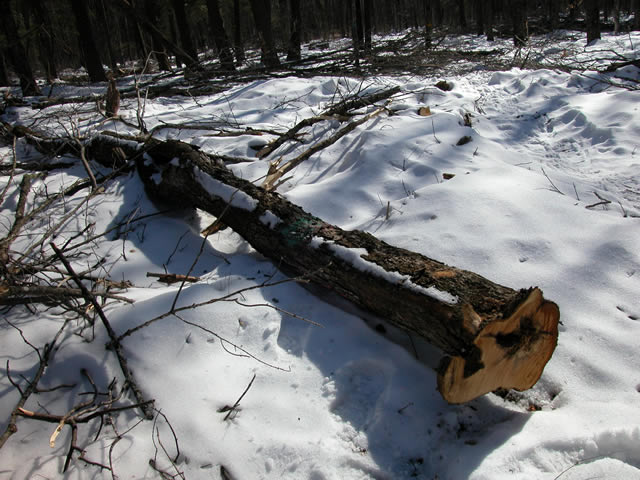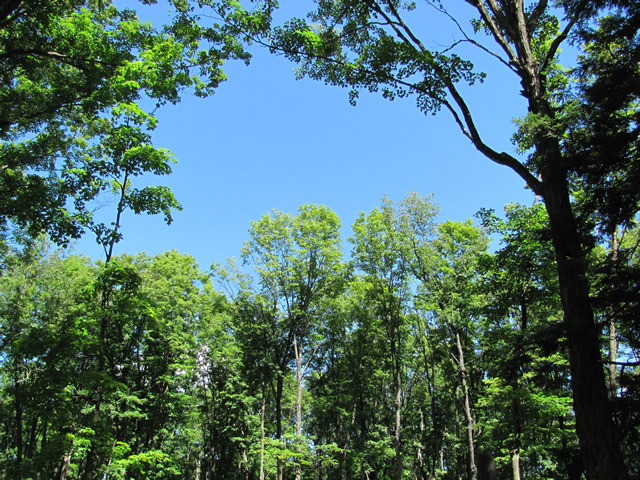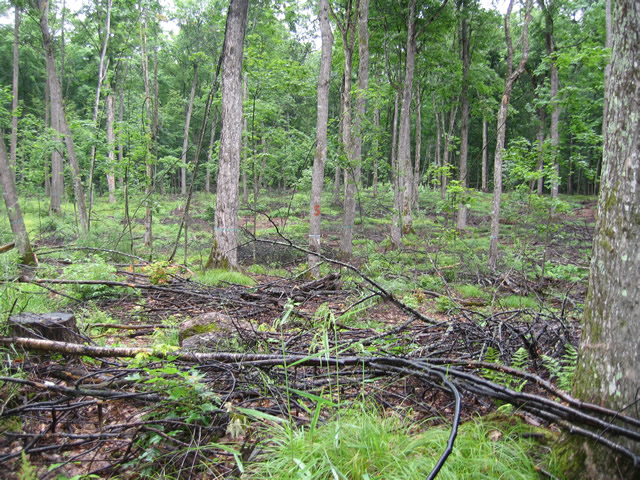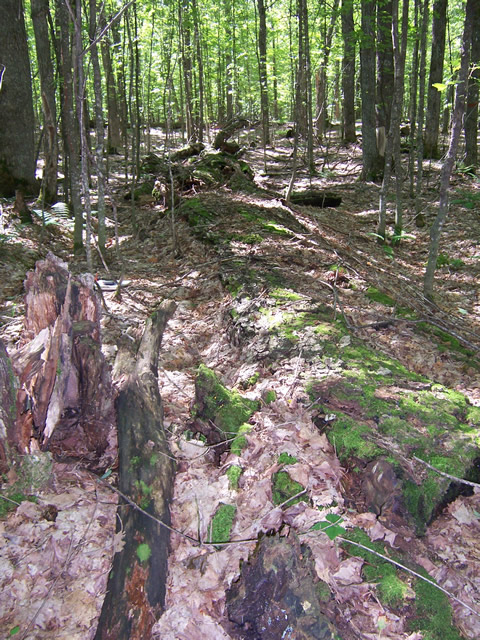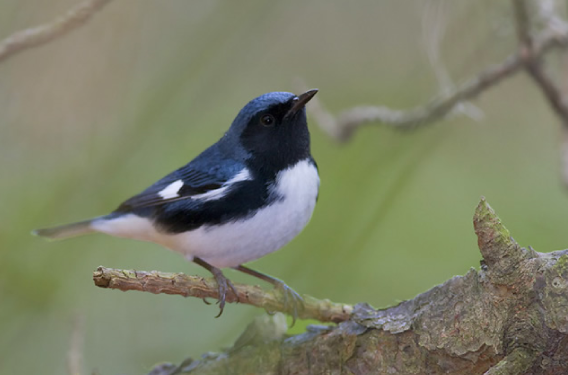Managed old-growth silvicultural study (MOSS)
The overall objective of this set of studies is to develop forest management techniques that accelerate the development of structural and compositional complexity in second-growth northern hardwoods so that they provide some of the ecological benefits of older forests while also allowing for ecologically sustainable timber product outputs. Research is being conducted in three focus areas, including silviculture (forest management), wildlife and economics. Results from this research will provide managers with sound biological and economic information on these new forest management approaches. If the experimental techniques ultimately produce enhanced structural and compositional forest complexity together with ecologically sustainable timber product outputs, they will offer practical management options for land managers in northern Wisconsin.
Background
The structure and composition of Wisconsin's northern forests have changed over time. Much of the state was cut over and burned during the late 1800s and early 1900s. This activity removed the primary forest and provided conditions favorable for aspen and birch. Over the last century, many of these aspen and birch forests have transitioned into the second-growth pine and northern hardwood forests that we see in northern Wisconsin today. Due to this forest management history and continued forest management today, the structure, composition and function of Wisconsin's northern forests have become simplified. To support forest health and resilience, it is essential to maintain a diversity of forest communities and age classes on the landscape, including forests with old-growth characteristics. The overall objective of this study is to investigate refinements to forest management techniques to allow active forest management to be used to restore structural and compositional complexity in second-growth northern hardwoods while also allowing for ecologically sustainable timber product outputs. The results of this study will provide scientifically sound, practical management options for land managers wishing to increase the biological complexity of their forests.
Study area
The Managed Old-growth Silvicultural Study is being conducted on public lands in northern Wisconsin: the Flambeau River State Forest, the Northern Highlands - American Legion State Forest, and the Argonne Experimental Forest (located within the Chequamegon - Nicolet National Forest).
Study design
Seven different forest management options are being studied at each of three different sites (see the Study area tab). These options vary in the amount of large dead wood (an important component of older forests) and the size and abundance of gaps in the tree tops (also known as canopy gaps). The seven management options being studied are as follows:
- Small gaps, no extra dead wood
We created approximately four 35-ft diameter gaps in the tree tops per acre by removing an average of three to four trees in a group to make each gap; we then removed scattered single trees ("thinning") in between the gaps. No effort was made to leave additional large dead wood. - Small gaps, extra dead wood added
The same as treatment (1), but we left behind some of the poor-quality, larger trees that would otherwise have been removed as part of the timber harvest that created the gaps and provided the thinning. These left-behind trees were either cut down and left down to increase the amount of large downed dead wood or were cut all the around the stem ("girdled") but left standing to increase the amount of large standing dead wood. - Large gaps, no extra dead wood
We created approximately one gap in the tree tops per acre, with the size of the gap alternating between 60-ft and 80-ft in diameter; we then removed scattered single trees ("thinning") between gaps. An average of ten trees were removed in a group to make each 60-ft gap; an average of 17 trees were removed for each 80-ft gap. No effort was made to leave additional large dead wood. - Large gaps, extra dead wood added
The same as treatment (3), but we left behind some of the poor-quality, larger trees that would otherwise have been removed as part of the timber harvest that created the gaps and provided the thinning. These left-behind trees were either cut down and left down to increase the amount of large downed dead wood or were cut all the around the stem ("girdled") but left standing to increase the amount of large standing dead wood. - Wind event, no extra dead wood
We used forest management to mimic the effects of a moderate-scale wind disturbance. We created small shelterwood cuts1 of one and three acres in size and removed scattered single trees at two different intensities ("heavy" and "light" thinning) over the rest of the treatment area. No effort was made to leave additional large dead wood. It should be noted that the intensity of cutting involved in this technique represents a rare event. It would only be done once in the lifespan of the trees at the site and only in a subset of the forest area is managed using this technique. - Wind event, extra dead wood added
The same as treatment (5), but we left behind some of the poor-quality, larger trees that would otherwise have been removed as part of the timber harvest that created the gaps and provided the thinning. These left-behind trees were either cut down and left down to increase the amount of large downed dead wood or were cut all the around the stem ("girdled") but left standing to increase the amount of large standing dead wood. - Passive management
This "treatment" area receives no active forest management; that is, no trees are harvested or cut and left on site. This passively managed stand allows us to compare the results of active management with no management to determine whether our efforts are accelerating the development of forest characteristics that would otherwise be produced on their own as the forest ages.
1Removing trees in the harvest area in a series of two or more cuttings so new seedlings can grow from the seed of older trees and in the shelter of those older trees. [definition modified from http://forestry.about.com/cs/glossary/g/shel_harv.htm [exit DNR]]
Objectives
Forest management objectives
- Compare and quantify the effectiveness of experimental forest management techniques in creating some of the attributes of old-growth forests such as large canopy gaps, species diversity, and the accumulation of large-diameter standing and downed dead wood
- Monitor the effects of treatments on the number, species, size, and spatial arrangement of seedlings and young trees growing in the stands
- Measure decay rates for dead trees (both standing and down), fall rates of standing dead trees (snags), and the development of new coarse woody debris (large snags and downed wood)
- Examine the growth and yield effects of the treatments
Economic objectives
- Quantify and compare the operational costs of conventional and alternative forest management practices in northern hardwood forests.
- Determine the economic tradeoffs, if any, for old-growth-related attributes that may result from the treatments (for example, an increase in American Martens in the study area)
- Quantify the effects of the alternative practices on regional timber supply and stumpage revenues
Wildlife objectives
- Investigate relationships between bird species and vegetation structure, and assess changes in bird species populations and assemblages under different forest management treatments.
- Quantify how forest management modifications change flying squirrel home ranges and habitat use, including nest site selection and behavior during nesting
- Evaluate the effects of white-tailed deer on forest regeneration
Education & outreach objectives
- Assess public response to the forest management treatments using on-site demonstration areas and forest visualization tools
- Prepare general interest articles and non-technical publications on developing compositional and structural characteristics more similar to those found in the old-growth forest for the general public and private forest landowners
- Develop a continuing education program for resource professionals on techniques for increasing compositional and structural complexity in second-growth forests
Timeline
| Year | Activity |
|---|---|
| 2004-2007 | Pre-treatment data collection
|
| 2007-2008 | Implement treatments & collect productivity data |
| 2008-2012 | Initial post-treatment measurements
|
| 2013-2057 on a 5+-yr remeasurement cycle |
Evaluate treatments and manage objectives Key factors for evaluation include:
|
Partners
- Wisconsin Department of Natural Resources
- Kemp Natural Resources Station [exit DNR]
- US Forest Service Northern Research Station [exit DNR]
- University of Minnesota Dept of Forest Resources [exit DNR]
- UW-Madison Dept. of Forest and Wildlife Ecology [exit DNR]
Resources
- Publications
-
Hanson, J.J., C.G. Lorimer, and C.R. Halpin. 2011. Predicting long-term sapling dynamics and canopy recruitment in northern hardwood forests. Canadian Journal of Forest Research, 41(5): 903-919 (https://cdnsciencepub.com/doi/abs/10.1139/x11-014 [exit DNR])
Hanson, J.J., C.G. Lorimer, C.R. Halpin, and B.J. Palik. 2012. Ecological forestry in an uneven-aged, late-successional forest: simulated effects of contrasting treatments on structure and yield. Forest Ecology and Management, 270: 94-107. (https://research.fs.usda.gov/treesearch/40874 [exit DNR])
Martin, K. J. 2006. Can small deer exclosures work? Woodland Management. XXVII (2)28-29.
Martin, K., Kassulke, N., and Rinaldi, T. 2004. Managing Wisconsin's old-growth: protecting and producing old forest characteristics. Insert in Wisconsin Natural Resources, Oct / Nov 2004. PUB-FR-293 2004. 16pp. (https://widnr.widen.net/view/pdf/nwri0p2ltm/Old-Growth-FR293 [PDF])
Steinhoff, S. G., T. R. Van Deelen, K. J. Martin, D. M. MacFarland, and K. R. Witkowski. 2012. Nesting patterns of southern flying squirrels in managed northern hardwoods. Journal of Mammalogy 93(2): 532-539. (http://www.asmjournals.org/doi/abs/10.1644/11-MAMM-A-032.1 [exit DNR])
- Selected posters
-
Fassnacht, K.S., T.W. Steele, E.A. Padley, C.G. Lorimer, K.J. Martin, B.J. Palik, A.W. D'Amato, T. Knoot, and D. Bronson. 2013. Assessing the use of silvicultural techniques to enhance forest complexity. Poster presentation at the Wisconsin Department of Natural Resources Science Services Open House. March 1, 2013, Madison, WI.
Knoot, T.G., T. Steele, K. Martin, K. Fassnacht, D. Bronson, B. Palik, T. D'Amato, E. Padley, and C. Lorimer. Nov 2012. Managing northern hardwood forests for old-growth characteristics and forest products: An economic assessment of novel forestry practices. Poster session presented at Heartland Environmental & Resource Economics Workshop, Urbana-Champaign, IL.
Martin, K.J., K.S. Fassnacht, B. J. Palik, T.W. Steele, C.G. Lorimer, M. Worland, S. Steinhoff. 2011. Managing northern hardwood forests for old-growth characteristics and forest products. Poster presentation. Joint meeting of the Wildlife Society & the Society of American Foresters. 2 Mar 2011, Wisconsin Dells, WI.
Worland, M., K.J. Martin, K.S. Fassnacht, and M.J. Mossman. 2011. Managing northern hardwood forests for old-growth characteristics: impacts on avian communities. Poster presentation. Joint meeting of the Wildlife Society & the Society of American Foresters. 2 Mar 2011, Wisconsin Dells, WI.
Worland, M., K.J. Martin, K.S. Fassnacht. 2010. How the diversity and conservation value of northern hardwood avian communities vary with old-growth forest attributes. Oral presentation. 2010 Midwest Fish and Wildlife Conference. Dec 2010, Minneapolis, MN.
- Silviculture
-
Bauhus, J., K. Puettmann, and C. Messier. 2009. Silviculture for old-growth attributes. Forest Ecology and Management, 258: 525-537.
Choi, J., C.G. Lorimer, J.M. Vanderwerker. 2007. A simulation of the development and restoration of old-growth structural features in northern hardwoods. Forest Ecology and Management, 249: 204-220.
Frelich, L.E. 1995. Old forests in the Lake States today and before European settlement. Natural Areas Journal 15: 157-167.
Goodburn, J.M. and C.G. Lorimer. 1998. Cavity trees and coarse woody debris in old-growth and managed northern hardwood forests in Wisconsin and Michigan. Canadian Journal of Forest Research, 28: 427-438
Hanson, J.J. and C.G. Lorimer. 2007. Forest structure and light regimes following moderate severity wind storms: implications for multi-cohort management. Ecological Applications, 17: 1325-1340.
Hanson, J.J., C.G. Lorimer, C.R. Halpin, and B.J. Palik. 2012. Ecological forestry in an uneven-aged, late-succesional forest: Simulated effects of contrasting treatments on structure and yield. Forest Ecology and Management, 270: 94-107.
Keeton, W.S. 2006. Managing for late-successional/old-growth characteristics in northern hardwood-conifer forests. Forest Ecology and Management, 235:129-142.
McComb, W. and D. Lindenmayer. 1999. Dying, dead, and down trees. Ch. 10 (p. 335-371) In: M.L. Hunter, Jr. (ed). Maintaining biodiversity in forest ecosystems. Cambridge University Press. New York, NY. 698 p.
Mladenoff, D.J., and J. Pastor. 1993. Sustainable forest ecosystems in the northern hardwood and conifer forest region: concepts and management. pp. 145-180 In: G. H. Aplet, N. Johnson, J. T. Olson, and V. A. Sample (eds), Defining sustainable forestry. Island Press, Washington, D.C.
Scheller, R.M. and D.J. Mladenoff. 2002. Understory species patterns and diversity in old-growth and managed northern hardwood forests. Ecological Applications, 12(5): 1329-1343.
- Wildlife
-
Barclay, R.M.R., and A. Kurta. 2007. Ecology and behavior of bats roosting in tree cavities and under the bark. pp. 17-60. In: M.J. Lacki, J.P. Hayes, and A. Kurta (eds). Bats in forests: conservation and management. The Johns Hopkins University Press, Baltimore, Maryland. 329 p.
Gilbert, J.H., J.L. Wright, D.J. Lauten, and J.R. Probst. 1997. Den and rest-site characteristics of American marten and fisher in northern Wisconsin. pp. 135-145. In: G. Proulx, H.N. Bryant, and P.M. Woodard (eds). Martes: taxonomy, ecology, techniques, and management. Proceedings of the Second International Martes Symposium. Provincial Museum of Alberta, Edmonton, Alberta, Canada. 474 p.
Howe, R.W., and M. Mossman. 1995. The significance of hemlock for breeding birds in the western Great Lakes region. pp. 125-139. In: G. Mroz and J. Martin (eds). Hemlock ecology and management. Proceedings of a conference. Sept. 27-28, 1995, Iron Mountain, MI. School of Natural Resources, College of Agricultural and Life Sciences, University of Wisconsin-Madison. Madison, WI. 200 p.
Howe, R.W., G. Neimi, and J.R. Probst. 1995. Management of western Great Lakes forests for the conservation of neotropical migratory birds. pp. 144 167. In: F.R. Thompson (ed), Management of Midwestern landscapes for the conservation of neotropical migratory birds. U.S. Department of Agriculture, Forest Service, North Central Forest Experiment Station Gen. Tech. Rep. NC 187; Detroit, Michigan.
Randall, J., and M. Walters. 2005. Deer and sedge: Bottlenecks to seedling regeneration in northern hardwood forests. Abstract. Joint ESA and ISECOL meeting in Montreal, Canada. August 7th - 12th.

